

Binary MLM compensation plan offers an excellent way to balance business growth and distributor growth. This article delves into how the Binary MLM plan works, its pros and cons, and why it’s an attractive business strategy for new and veteran distributors alike.
Binary compensation is the perfect way to understand how to compensate your distributors and maintain your perfect performing recruits through a balanced business and distributor growth. The binary MLM compensation plan has increased in popularity because it balances business growth and distributor growth.
The two-legged model encourages teamwork with attractive compensations. MLM Binary plan is a unique business strategy that is used by a lot of Networking marketing companies. Many people have been drawn to this plan because of its potential to grow a business quickly and widely. The practical encouragement of teamwork to build a robust binary compensation plan is an attractive option for both seasoned players and newcomers.
Binary compensation is extensively used due to its potential to increase and expand quickly. Binary compensation pays new and veteran distributors alike. But this can also prove harmful if not used wisely as it leads to losing incoming by overpaying distributors. Also, alternating distributors on popularity may be challenging as MLM compensation plans are long-term.
The predetermined fee allocation for distributors can be a solution to this problem. The essence of a binary MLM plan is that you can prompt good commissions with each member or leg you build. The binary plan’s network creates enhanced business opportunities with active recruits, sales, and higher profits.
The highlight of a well-established binary MLM company will have an extensive line of frontline distributors, and there will be an exponential increase in these numbers. Once a distributor reaches a certain level, no more chronic effort is required from the distributor’s end, unlike the other profitable companies that require much effort from their frontline distributors to supply income to distributors.
The Binary MLM compensation plan is a popular structure in network marketing, but opinions on it are definitely mixed. Some distributors love its clear-cut rules and unique approach, while others prefer more freedom.
A key difference between a binary plan and a pyramid scheme is that a binary plan always involves a genuine product or service. Pyramid schemes, on the other hand, focus solely on recruiting new members to make money, which is illegal.
The binary plan is one of the three main compensation models in network marketing, alongside the matrix and unilevel plans. It’s a proven system that has helped many businesses succeed. Let’s delve deeper into the binary MLM plan and explore both its advantages and disadvantages.
The Binary MLM plan utilizes a two-legged structure, where every distributor leads two branches or dual parts in each section. In the Binary model, the distributor layout of the tree has a structure with two branches or dual parts at each section. A distributor forms the lead, and the members sponsored by them form the tree’s two subsections. The two sponsored members would form the next set of distributors and introduce members to their downline to form their downline, and so on.
The compensation is tailed by using legs. This form fosters teamwork, and the distributors are paid based on the underperforming leg. New distributors are added to every degree as new branches are created, and as a range is attained, the distributor is moved to the left.
Members don’t remain on a level for long; they move up the lines and form the top levels. The downlines also earn the distributors a bonus each month.
The commission is offered not on levels but business volume. The commissions earned by distributors are earned solely through downlines.
The distributors can build their downlines in two ways, side by side or top-down and place members either on their right or left leg. This creates an equality-oriented approach with rewards, collaboration, innovation, etc.
Let’s imagine a scenario in a binary tree network marketing structure.
Distributor X brings in Distributor A to their team. Then, Distributor A sponsors a new member, Distributor B. In a binary tree system, Distributor B gets placed on the left side of Distributor A’s team.
Next, Distributor A adds another member, Distributor C, to their team. This time, Distributor C chooses to join on the right side since the left side is already occupied. Now, Distributor A has built a team with members on both sides, and they start earning commissions.
It’s important to remember that Distributor A is both the “sponsor” who introduced Distributor B and C to the opportunity, and the “parent” who guides and supports their growth within the team.
A binary MLM plan is the most potent multi-level marketing plan in the industry. It’s proven to be incredibly powerful, bringing massive success to many businesses. This is because it allows both business owners and users to profit from their participation.
The Binary plan is excellent for simple online cooperation. In a binary mlm compensation plan, distributors are paired into upline and downline teams. In this method, businesses encourage teamwork by offering attractive compensation packages.
The binary MLM business strategy is widespread and growing in popularity. Many Networking companies use a binary MLM business strategy to encourage teamwork with attractive compensations. A binary MLM compensation plan provides rapid growth opportunities for businesses.
Unlike most MLM plans, binary MLM works on the principle of two-legs instead of three-legs. In this plan, members have two branches: left and right, with each having a new member. This creates a tree that can continue indefinitely until the entire marketplace is targeted.
In a binary compensation plan, distributors have precisely two options for building a downline: side-by-side or top-down. The commission is based on business volume, and distributors earn commissions solely through downlines.
It’s called binary marketing plan because there are only two ways to structure your organization. When we talk about binary plans, the most common example is binary trees.
In the first case distributor A sponsors two members C in the right and B in the left leg of the binary tree. Here A is both the Sponsor and parent of B and C.
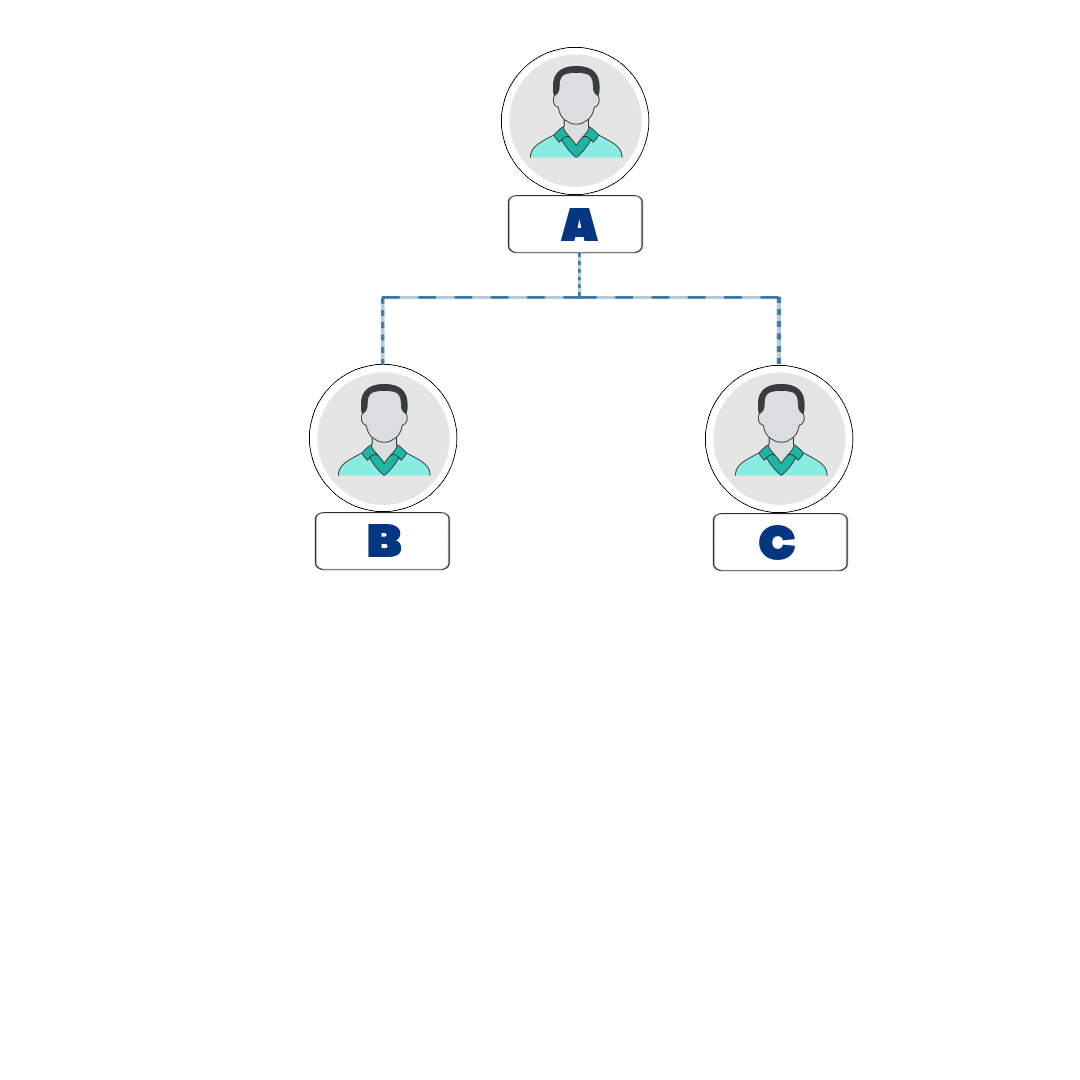
In the second case, distributor A sponsors B, C and D. B is added to the left leg and D to the right leg. Here A also sponsors C in the left leg. Binary works with two branches on each side, and therefore C cannot be placed in a different branch, rather C is placed under B in the left leg. This process is known as spillover in binary. Here for C, B is the parent, and A is the Sponsor.
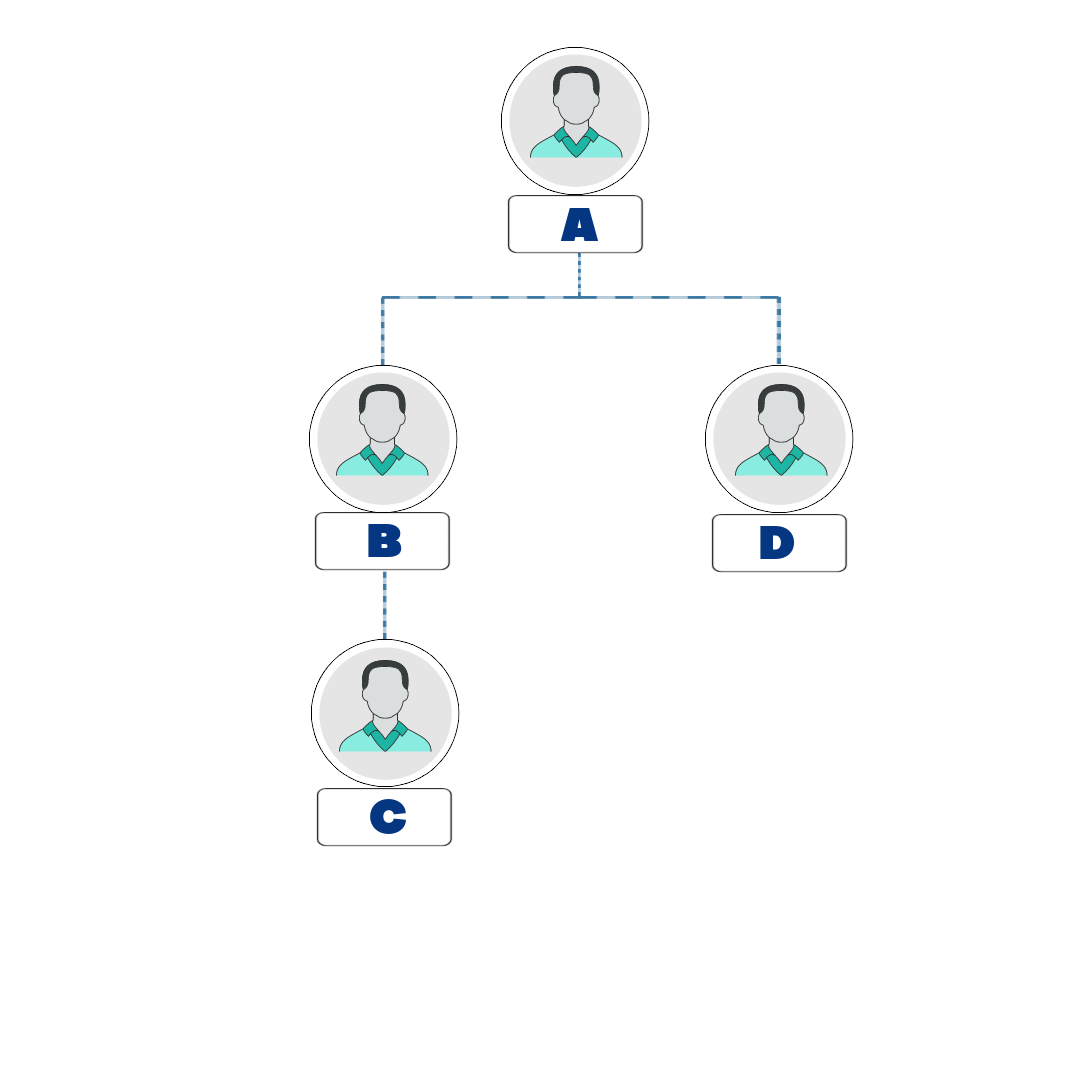
In a binary MLM plan, when a distributor successfully recruits two new members, they complete the “first level” of their team. This structure resembles a tree, with the distributor at the root. Now, the next members they recruit will automatically be placed in the next available position within the team.
However, it’s important to note that how these new members are “spilled over” can differ significantly between companies. Some plans might prioritize filling one side of the tree first, while others may have more complex rules based on factors like member activity or recruitment dates. These variations are a result of the unique way each MLM company customizes its compensation plan.
The binary network marketing plan works by spilling. Spillover occurs when a distributor enrolls more than two members on the first level, forcing new members to be placed under the sponsoring distributor’s downline. There are two types of spillovers: extreme left or extreme right spilling.
Extreme Left Or Extreme Right Spilling
Spillover preferences can be set to favor either the left or right side of a distributor’s downline in a binary compensation plan. Many companies implement this strategy to encourage distributors to actively build their teams on both sides. To earn commissions, distributors typically need to achieve a balance in their downline by generating sales on both the preferred and non-preferred sides. This incentivizes them to work diligently to recruit and mentor new distributors across their entire organization. Distributor A sponsors B, C in left side. B occupies the direct left leg position of A. C is placed under the direct left of B, which is called extreme left. In another case, B occupies the direct right leg position of A . A sponsor a new user C in the right leg, and C is placed under the direct right of B, also called extreme right.
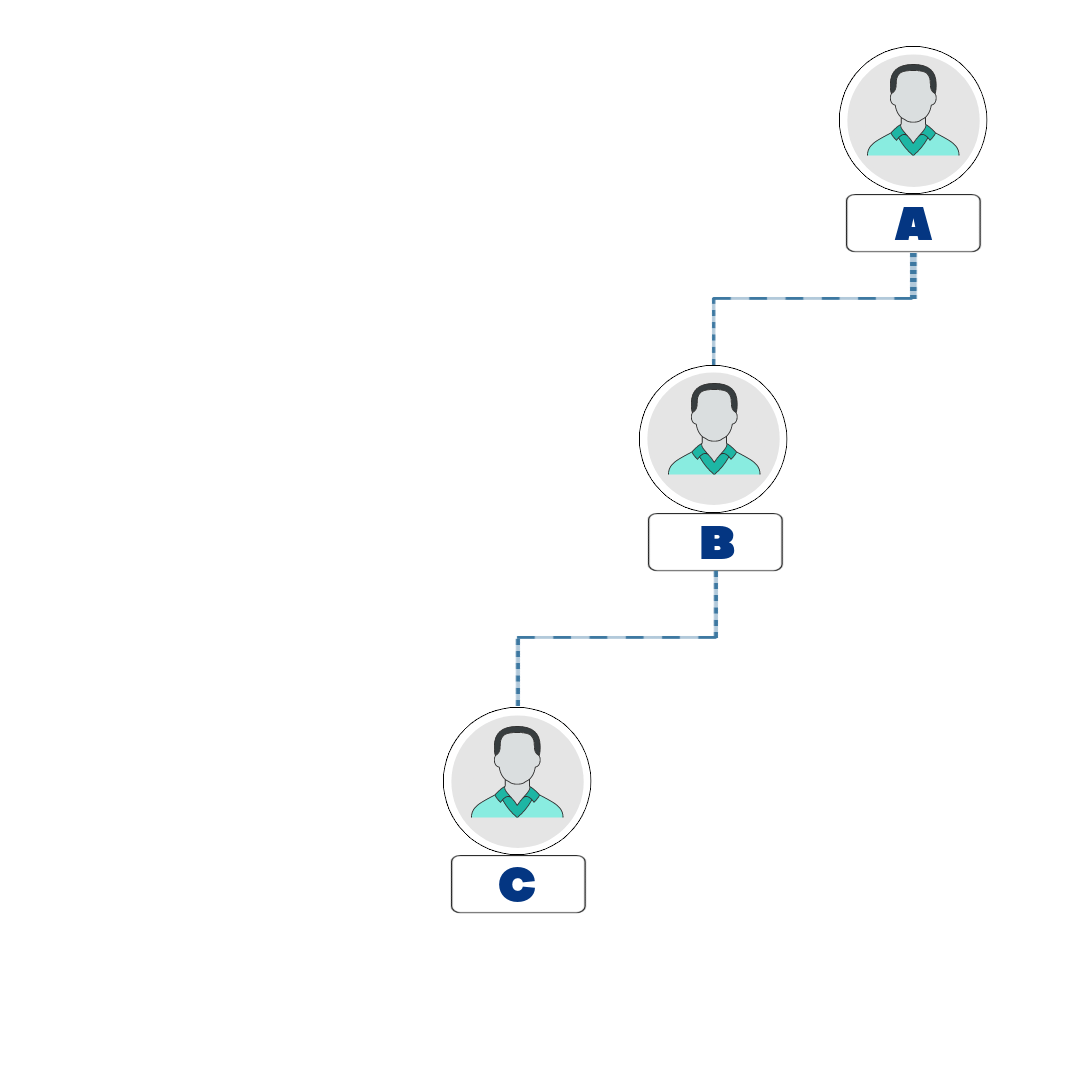
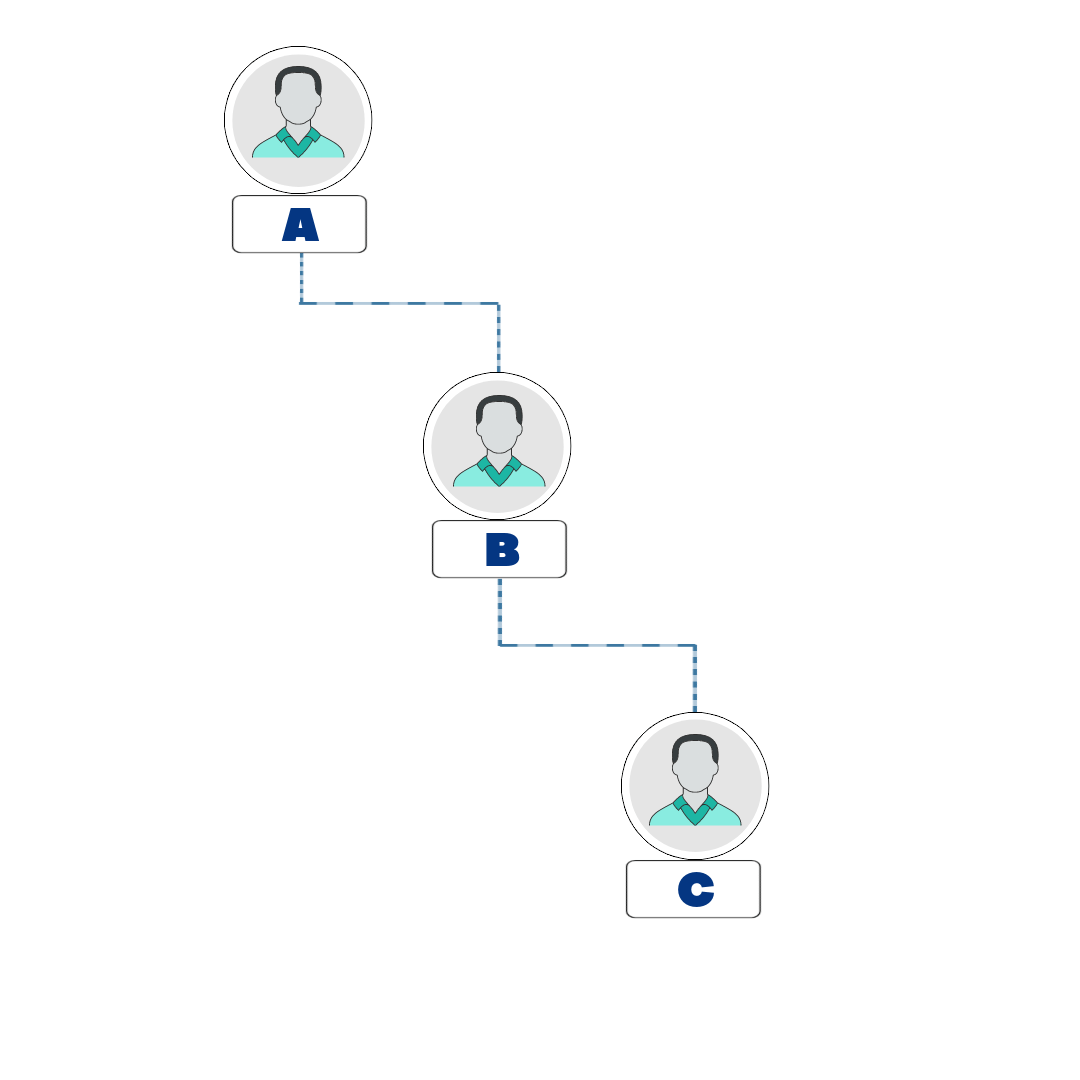
Pay Leg Or Weaker side Spilling
In a balanced binary compensation plan, new members are strategically placed to even out the sales volume between the two sides of the organization – typically referred to as the “left leg” and the “right leg.” The side with the lower overall sales volume is designated as the “weak leg.” This approach ensures that the team’s growth is not skewed towards one side, potentially hindering overall development and income potential. By adding new members to the weaker leg, the goal is to create a more balanced and sustainable structure, ultimately leading to increased sales and earnings for the entire organization.
Balance Spilling
In the Balance spilling case, the users are placed in a 1:1 ratio and filled in the left to right order. This preference for spilling ensures that the tree remains balanced. In other words, for every node added to the left side of the tree, a node is also added to the right side. This balancing act is achieved by carefully considering the order in which new members are added. Specifically, members will be added to the tree based on left-right combinations, ensuring a consistent and even distribution of nodes on both sides.
Multiple Position Spilling
Some binary compensations offer multiple positions to the distributors. Imagine a binary tree structure, common in some multi-level marketing companies. A ‘premium joining package’ might allow you to purchase multiple positions within this tree. Let’s say this package grants you three positions. These positions would typically be placed sequentially in the tree. Once the first three positions are filled, any additional positions purchased would ‘spill over’ to the next available positions in the tree. This spilling feature is usually available when a company offers packages that include multiple positions within their binary compensation plan.
The binary plan contains two legs known as weak leg and strong leg . The leg with more volume is called the strong leg, and the lesser leg is called the weak one. The weak and strong leg can either be on the left or right. Binary Compensations are provided based on the weak leg. The volume accumulated in the left and the right leg is used for binary commission calculations. The sales ratio is counted in a 1:1 or 2:1 ratio. Commissions of a 1:1 ratio are paid when a 1:1 ratio is achieved in the left and right leg And Commission of the 2:1 ratio is paid when the 2:1 ratio is achieved in the left and right leg.
Here B joined with a 100 USD package with a PV of 100, and C with a 100 USD package with a PV of 100. Now A will get a 100 PV from both left and right. If we set 10 % as binary, then A will obtain a commission of 10% of 100 = 10 USD as binary. Once Match happens left, and right side of A becomes 0.
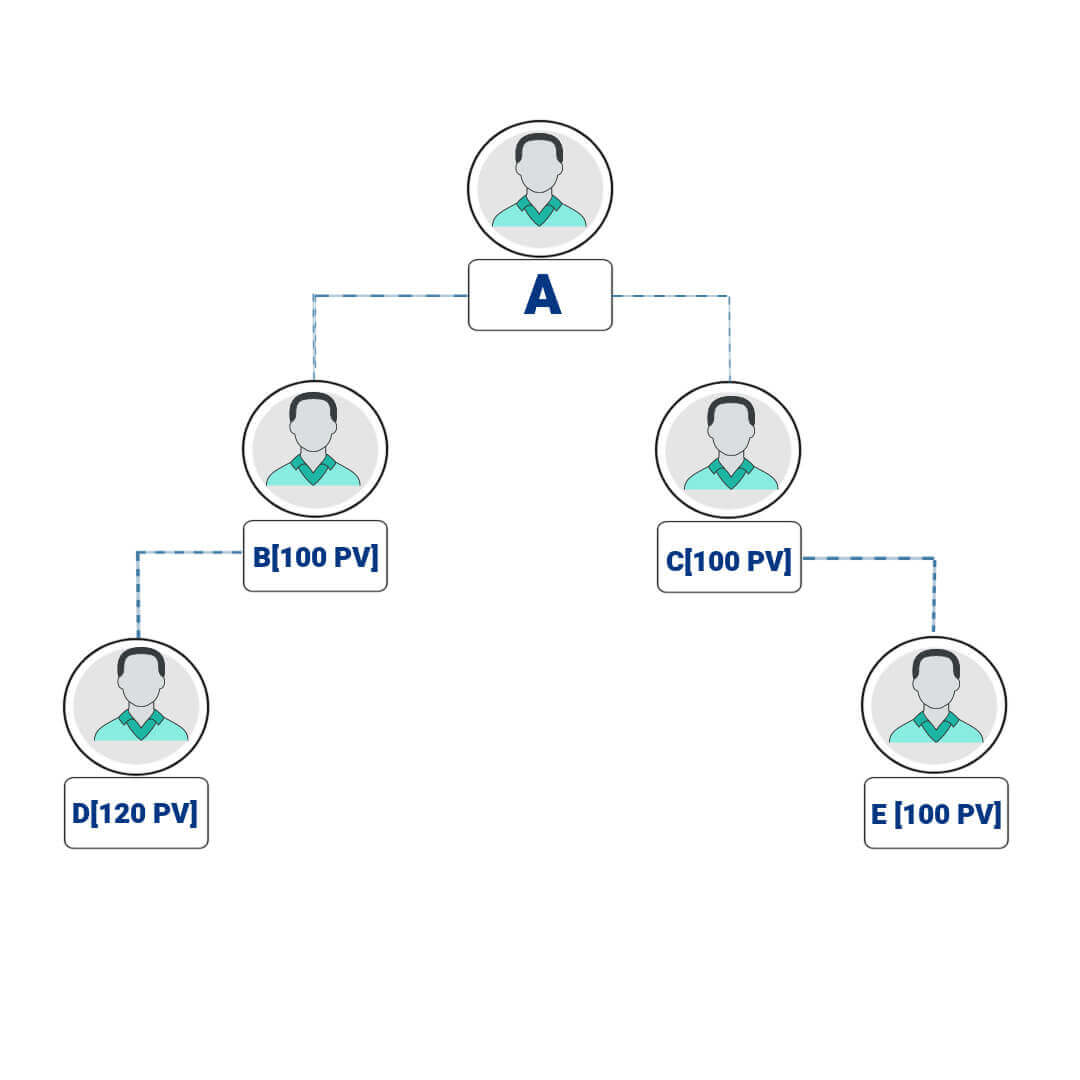
If B sponsors a new user, D, into the left group, D joined with a 120 USD package with a PV of 120 and if C sponsors E into the right group, E joined with a 100 USD package with a PV of 100. Here left of A is 120, and the right has 100, B also earn 120 PV in left from D and right of B is 0 And C also earn 100 PV to the right from E and left of C is 0. Now A will get 10% of the weaker side as binary, 10 % of 100 = 10 USD. Now left leg of A contains 20 PV as carrying forward, which can be utilized for the following binary Commission, and the Right leg of A becomes zero. Some companies flush out the carry forward after getting the binary commission
B joined with a 200 USD package with a PV of 200, and C joined with a package of 100 USD with a PV of 100. This forms a 2:1 ratio. If we set 10 % as binary, then A will obtain a commission of 10% of 100 = 10 USD as binary, and the left and right of A become 0. Some companies offer 2:1 for the first pair and 1:1 for the rest.

There are two types of Binary capping methods: Sales, volume-based binary capping, and Commission-based binary capping.
Sales and volume-based binary capping
In a binary MLM plan, your commission is determined by comparing your sales volume between your two teams (often called “legs”). Imagine a scenario where you have two teams: your left team generates 200 sales volume points (SV), and your right team generates 400 SV.
Let’s say the company has set a “binary capping” of 100 SV. This means that only the first 100 SV from each team will be considered for your commission calculation.
Any sales volume exceeding the cap is ‘overflow’ and won’t contribute to your current binary commission. In this example, 100 SV from the weaker leg (left) and 200 SV from the stronger leg (right) would be excluded.
The company can adjust this capping period – it might be daily, weekly, or monthly, depending on their specific plan rules.
Commission-based binary capping
In MLM with a binary plan, a “capping value” is established to limit the commissions a distributor can earn. This value is determined by comparing the distributor’s initial investment (joining package) to the potential commissions they can receive.
For example, if Distributor A joins an MLM company with a $1,000 joining package, the company might set a capping value of $5,000. This means that regardless of how successful Distributor A’s team grows, their total commissions from the binary plan will not exceed $5,000.
These capping values can be applied on different timeframes, such as daily, weekly, or monthly, to further regulate earnings within the MLM structure.
1.Matching Bonus
Matching bonuses are a common incentive in network marketing programs. Essentially, when you personally sponsor someone who successfully earns a commission, you receive a matching bonus. This bonus often represents a percentage of the commission your sponsored team member earns.
Think of it like this: you’re not just rewarded for your own sales, but also for the success of the team you build. This creates a powerful incentive for distributors to actively mentor and support their downline, fostering a collaborative and supportive environment within the network.
Matching bonuses can significantly increase your earning potential as your team grows and thrives. By helping your team members succeed, you not only boost their income but also increase your own earnings through the matching bonus structure.
2.Custom Bonus
Custom bonuses” are a flexible perk within the multi-level marketing (MLM) world. These bonuses aren’t one-size-fits-all. Instead, each MLM company or individual distributor can design them to fit their unique goals and needs.
For example, a company might offer a custom bonus to reward a team that exceeds a specific sales target. Alternatively, they could incentivize distributors to acquire a certain number of new recruits.
On a more individual level, a distributor might create a custom bonus for themselves to stay motivated. This could involve rewarding themselves with a vacation or a new piece of technology after reaching a personal sales milestone.
The beauty of custom bonuses lies in their adaptability. They provide a powerful tool for both companies and individual distributors to recognize achievements, foster healthy competition, and ultimately, drive greater success within the MLM network.
3.Return Of Investment
Many MLM companies offer bonuses to incentivize distributors to invest in their businesses. These bonuses often revolve around the concept of Return on Investment (ROI). Essentially, a distributor might receive a bonus for making a specific financial commitment to their enterprise.
For example, a distributor could earn a bonus by spending a certain amount of money on marketing materials like flyers, social media ads, or even on stocking up on inventory. This encourages distributors to actively participate in building their businesses and drives overall sales within the MLM network.
By offering ROI-based bonuses, MLM companies aim to motivate distributors to invest in their own success and contribute to the growth of the entire network.
4.Binary Commission Bonus
This bonus rewards you based on how well both sides of your downline team are performing. Think of it like a balanced scale. You earn a commission when both sides of your team generate a similar amount of sales. Many MLM companies use software to automatically calculate your binary commission based on the specific rules of their compensation plan.
5.Leveling Bonus
The Leveling Bonus, sometimes called the Depth Bonus, rewards distributors for building a deep and wide network within their team. Think of it like climbing a ladder – you earn a bonus for reaching each new level of distributors. For instance, you might receive a bonus when you have 10 levels of distributors beneath you in your organization. This bonus incentivizes distributors to focus on long-term growth and encourage consistent recruitment throughout their team.
6.Fast Start Bonus
Essentially, these bonuses are a reward given to you when a new distributor joins your team and makes their first purchase or sale. Think of it as a welcome gift and a little extra motivation to get them off to a flying start. MLM companies use Fast Start Bonuses strategically. They’re designed to encourage new distributors to jump in with both feet and start building their businesses quickly. This initial boost can provide a much-needed confidence boost and fuel their enthusiasm for success.
7.Rank Advancement Bonus
Many multi-level marketing companies have a tiered system for their distributors, similar to a ladder with increasing levels. Climbing this ladder, or advancing in rank, often unlocks exciting rewards. One such reward is the Rank Advancement Bonus. This bonus specifically recognizes and incentivizes distributors who successfully climb to a higher level within the company’s organizational structure, often visualized as a ‘binary tree’.
Supercharge your MLM business with binary compensation plan and reach new heights of success. Click now to discover how.
Binary compensation forms one of a kind in all the different MLM compensation plans. The unique structure, commissions, and constructing techniques of exceptional profit gain for everyone involved. Binary plans offer a range of plan regulations acceptable Binary plans offer a range and clear compensation plan regulations that are convenient for any distributor for their business growth.
Binary plans are a force to be reckoned with in the industry. They have a different structure and rules than the other compensation models that exist. If you want to take advantage of this unique type of model, you’ll need to rethink your plan structure to maximize its potential. A binary networking structure is flexible and straightforward, making it highly versatile for your purposes.